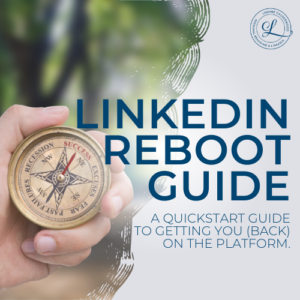Most people use AI like they use a microwave: quick, convenient, and only when they're…

Conquering Content Creation Fear: Overcome Imposter Syndrome and Shine on LinkedIn
Have you ever found yourself scrolling through LinkedIn, marveling at the polished posts of influencers and thinking, “I could never be that insightful or engaging”? You’re not alone. Many of us wrestle with the twin shadows of imposter syndrome and comparisonitis, especially when it comes to content creation. But what if I told you that your unique voice is not only necessary but desired in the vast sea of online content? Let’s dive into how you can overcome these challenges and start creating content that resonates and impacts, even on platforms as formidable as LinkedIn.
What is going on with us?
Imposter syndrome and comparisonitis are two psychological phenomena that can significantly affect individuals, particularly in professional settings like LinkedIn. Here’s a breakdown of what they are and how they manifest, especially when scrolling through LinkedIn’s home feed.
Imposter Syndrome is the internal experience of believing that you are not as competent as others perceive you to be. Despite evidence of success, individuals with imposter syndrome attribute their accomplishments to luck or timing rather than their own skill, intelligence, or qualifications. They often fear being exposed as a “fraud” or fear that they don’t truly belong in their professional circles.
When scrolling through LinkedIn’s home feed, imposter syndrome can manifest as a feeling of inadequacy when viewing others’ professional achievements, endorsements, or content. You might see peers celebrating promotions, leading major projects, or sharing thought leadership articles and feel like you don’t measure up or don’t deserve the successes you’ve had. This can lead to reluctance to share your own achievements or content, fearing it won’t be good enough or that you’ll be judged as lacking.
Comparisonitis refers to the compulsive act of comparing oneself to others, leading to feelings of inadequacy, jealousy, and low self-esteem. It stems from a focus on how one measures up against peers based on accomplishments, appearance, and other success metrics, often ignoring context and differences in journeys.
On LinkedIn, comparisonitis might strike as you notice the curated success stories, polished profiles, and high engagement rates on others’ posts. This platform, designed to showcase professional success, can exacerbate feelings of falling behind or not achieving enough, especially when your own experiences or achievements seem modest in comparison. It can lead to a distorted view of your own value and contributions, making you hesitant to engage or share your own stories for fear they won’t stack up.
When both imposter syndrome and comparisonitis strike simultaneously, the effect can be paralyzing. Scrolling through LinkedIn’s home feed becomes an exercise in self-doubt and anxiety. You might hesitate to update your profile, engage with content, or post your achievements. This hesitation can stem from a fear of being perceived as less successful or from a belief that your contributions aren’t worthy of recognition.
Understanding these phenomena is the first step toward mitigating their impact. It involves recognizing the curated nature of social media, acknowledging your own accomplishments, and focusing on your unique journey and growth. By confronting these challenges directly, individuals can begin to participate more fully and authentically in LinkedIn and other professional environments, celebrating their own successes and engaging with their network without the shadow of self-doubt.
The Reality of Content Creation: Pros and Cons
It’s crucial to understand the landscape of content creation, particularly on LinkedIn. This understanding will ground our strategies in reality and prepare us for both the sunshine and the rain.
Pros of Content Creation on LinkedIn:
- Visibility and Networking: Crafting and sharing your content elevates your profile, making you more visible to potential clients, employers, or collaborators. It’s a digital handshake extending beyond your immediate network.
- Authority and Trust: Regular, insightful posts establish your expertise in your field, building trust with your audience. This authority can translate into more opportunities and connections.
- Personal Brand Development: Each post is a brick in the edifice of your personal brand. Over time, your content paints a picture of who you are, what you stand for, and the value you bring to your professional community.
Cons of Content Creation on LinkedIn:
- Time Investment: Quality content creation requires time, both in ideation and execution. It’s a commitment that can sometimes feel daunting alongside other responsibilities.
- Exposure to Criticism: Putting your thoughts out there opens you up to feedback, not all of which is constructive. Learning to sift the useful from the hurtful is a skill developed over time.
- Comparison and Discouragement: Seeing others’ seemingly flawless posts can lead to discouragement and the dreaded “comparisonitis,” where you measure your behind-the-scenes against everyone else’s highlight reel.
Tips for Getting Started
Understanding the landscape allows us to navigate it with more confidence. Here are some strategies to help you begin:
- Embrace Your Unique Voice and Expertise: Understand that your perspective is unique and valuable. You’ve accumulated experiences, insights, and skills that no one else has in quite the same way. Remind yourself that there is an audience out there that can benefit from what you know. Start by listing your achievements, skills, and areas of knowledge. This list will serve as a tangible reminder of your expertise and worth.
- Begin with Baby Steps: You don’t need to launch with a comprehensive article or video. Start by sharing small insights, commenting on others’ posts, or sharing interesting articles with your thoughts added. These smaller contributions will build your confidence and help you find your voice without the pressure of creating perfect, original content from the start.
- Set Realistic Goals: Define what success looks like for you in the early stages. It might be as simple as posting once a week or engaging with three to five posts daily. By setting achievable goals, you’ll build momentum and a sense of accomplishment that can counter feelings of imposter syndrome.
- Create a Supportive Environment: Surround yourself with peers, mentors, or a community that uplifts and supports your content creation efforts. Whether it’s a LinkedIn group, a professional network, or a mentorship program, being around others who are on similar journeys can provide encouragement, feedback, and a sense of belonging.
- Focus on Learning and Growth: Adopt a growth mindset by viewing content creation as a learning process. Each piece of content is an opportunity to improve, gain feedback, and refine your message. Mistakes and missteps are part of the journey and valuable lessons rather than evidence of inadequacy.
- Celebrate Small Wins: Acknowledge and celebrate every step forward, no matter how small. Did you make your first post? Engage in a meaningful conversation? Receive positive feedback? These are all milestones worth recognizing and can help shift your focus from fears to achievements.
By implementing these strategies, you can begin to dismantle the barriers imposed by imposter syndrome. Remember, the key is to start somewhere, anywhere, and to keep moving forward. With each step, you’ll find your confidence growing, and the voice that once whispered doubts will start to cheer you on.
Now that we’ve explored the realms of content creation on LinkedIn, the ball is in your court. Remember, the world of LinkedIn is vast and varied, and there’s a niche for every voice, especially yours. Start today by drafting your first post or engaging with someone else’s content. Embrace your unique insights and experiences. The only content you’ll regret is the content you never created.
To your success,
Leanne
Ready to get back onto LinkedIn? Download this free LinkedIn Reboot Guide, and get yourself *back* into the LinkedIn game!
RELATED – Your Untapped Voice: The Power of Personal Branding for Everyone
RELATED – The risks of not starting a personal brand in 2024
RELATED – Overcoming Imposter Syndrome When Working On Your Personal Brand
RELATED – Authentic Personal Branding in Sales




